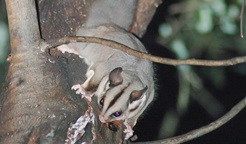Dharawal National Park
Learn more
Learn more about why this park is special
Dharawal National Park is a special place. Here are just some of the reasons why:
Park history

Dharawal was proclaimed a national park in 2012 following significant community involvement. Previously, it operated as a state conservation area and, before this, a water catchment area managed by Sydney Water. Seventy years of restricted public access has kept the area largely undisturbed, so pristine surroundings await you on your visit.
Inspiring scenery

Prepare to be awed by the beautiful dense vegetation and rugged Hawkesbury sandstone that dominates the park's landscape. Set off on a bushwalk to discover eucalypt and shale forests, stunted woodlands and windswept heath. Explore further to find patches of rainforest and extensive sedgeland amongst the scenic terrain.
- 10B cycling trail 10B cycling trail in Dharawal National Park offers excellent easy cycling for enthusiastic bike riders, with a picturesque picnic spot along the way.
- Minerva Pool walking track Minerva Pool walking track winds through the traditional country of the Aboriginal Dharawal People. Enjoy a short bushwalk and then picnic at Minerva Pool, in Dharawal National Park, near Campbelltown...
- O'Hares Creek lookout For great gorge views near Campbelltown and Wollongong in southern Sydney, O'Hares Creek lookout in Dharawal National Park offers breathtaking scenery and birdwatching along a family-friendly walking ...
Ancient landscapes

Dharawal National Park is the traditional land of the Dharawal Aboriginal people. Their long connection with this Country; the land and waterways, and the plants and animals that live in it feature in all facets of Aboriginal culture and are associated with Dreaming stories and cultural learning that is passed on today. The park protects several ancient Aboriginal sites, including drawings and axe-grinding grooves.
- Jingga walking track Jingga walking track, in Dharawal National Park, is a short yet challenging walk to a waterhole, offering picnic and birdwatching opportunities.
- Minerva Pool walking track Minerva Pool walking track winds through the traditional country of the Aboriginal Dharawal People. Enjoy a short bushwalk and then picnic at Minerva Pool, in Dharawal National Park, near Campbelltown...
A crucial catchment

O'Hares Creek catchment, on the Register of the National Estate is home to 17 vulnerable, rare or threatened species, and feeds the park's eucalypt forest, woodland, heathland, and sedgeland habitats. More than 500 plant species occur within the park, providing a home to a wide range of animals, including koalas and long-nosed potoroos, swamp wallabies, eastern wallaroos, New Holland honeyeaters and countless birds.
- Maddens Falls Enjoy scenic waterfall views at Maddens Falls lookout near Helensburgh, a great reward after a long bushwalk and the perfect place for birdwatching and photography.
- O’Hares Creek lookout walking track Gather the family and head to O’Hares Creek lookout walking track in Dharawal National Park, south of Campbelltown and near Appin. It’s a great getaway with scenic views and birdwatching.
Plants and animals protected in this park
Animals
-

Swamp wallaby (Wallabia bicolor)
The swamp wallaby, also known as the black wallaby or black pademelon, lives in the dense understorey of rainforests, woodlands and dry sclerophyll forest along eastern Australia. This unique Australian macropod has a dark black-grey coat with a distinctive light-coloured cheek stripe.
-

Peron's tree frog (Litoria peroni)
Peron’s tree frog is found right across NSW. These tree-climbing and ground-dwelling Australian animals can quickly change colour, ranging from pale green-grey by day, to a reddish brown with emerald green flecks at night. The male frog has a drill-like call, which has been described as a 'maniacal cackle’.
-

Sugar glider (Petaurus breviceps)
The sugar glider is a tree-dwelling Australian native marsupial, found in tall eucalypt forests and woodlands along eastern NSW. The nocturnal sugar glider feeds on insects and birds, and satisfies its sweet tooth with nectar and pollens.
-

Southern boobook (Ninox novaeseelandiae)
The southern boobook, also known as the mopoke, is the smallest and most common native owl in Australia. With a musical 'boo-book' call that echoes through forests and woodlands, the southern boobook is a great one to look out for while bird watching.
-

Eastern water dragon (Intellagama lesueurii lesueurii)
The eastern water dragon is a subaquatic lizard found in healthy waterways along eastern NSW, from Nowra to halfway up the Cape York Pensinsula. It’s believed to be one of the oldest of Australian reptiles, remaining virtually unchanged for over 20 million years.
Look out for...
Sugar glider
Petaurus breviceps

The sugar glider is a tree-dwelling Australian native marsupial, found in tall eucalypt forests and woodlands along eastern NSW. The nocturnal sugar glider feeds on insects and birds, and satisfies its sweet tooth with nectar and pollens.
